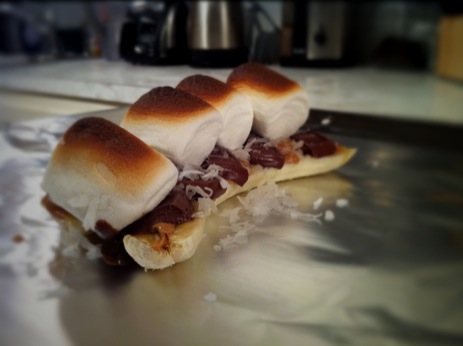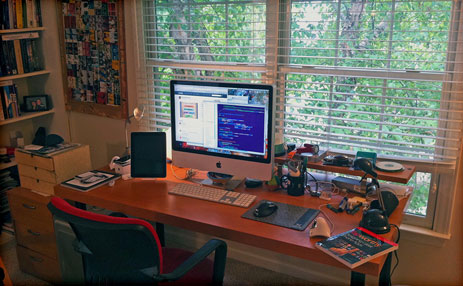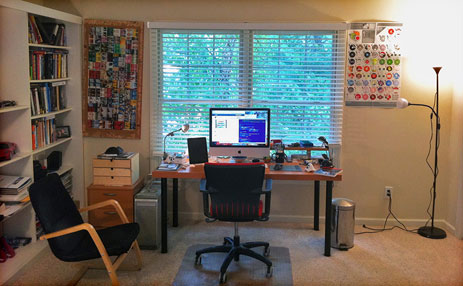Susan Orlean’s advice for aspiring writers which is now no longer relevant. So I guess you should start a blog or something.
Month: September 2010
Will Vintage and Modern Mashups Ever Stop Being Cool? →
Perhaps. But not today. Case in point? This Etch A Sketch iPad Case.
Attaching a 102-Year-Old 35mm Lens Onto a Canon 5D →
Tim Civan gets some stunning, vintage-looking images of modern-day New York. (Via Jim Ray.)
Khoi Vinh’s Thoughts on News and User Experience →
Khoi Vinh:
The old equation for news used to be: journalism (the reporting and editing) + presentation (laying out the news or preparing it for broadcast) + distribution (delivering newspapers or broadcasting news over the air).
Now the equation for news is: journalism + presentation + user experience + distribution. Hence, the reason attention and trust are so much more valuable now whereas they used to be somewhat inconsequential as it related to distribution.
Khoi’s 30-minute presentation, which is the basis for his above blog post, can be seen on swissmiss. A lot of great gems of wisdom in his presentation — especially if you’re involved with any sort of content distribution.
How I Write an Article
To start most articles I just brain dump into Notational Velocity or Simplenote. My location makes no difference (which is why I love Simplenote and Notational Velocity so).
I often times start an article by writing what I assume will be the introduction (though it’s likely to get changed dramatically before all is written and done with). This introduction is, to me, the heart of what I want to actually say.
Then I just start pecking away. I write in Markdown and in short, incomplete sentences. This first-draft writing stage is when I love my article the most. It’s full of bullet points, convictions, trains of thought, and, most importantly, delusions of grandeur.
If by chance the keyboard and I get into a flow I may write the whole piece all at once, but that is rarely the case. A lot of times I have a substantial amount of research and/or thinking to do in order to get a well rounded article. And so I start with my basic ideas and assumptions and then answer more questions to fill in the gaps with juicy details and desirous how-tos.
This is especially true of my reviews. I start typing and end up with a whole lot of very ugly text. Just lots and lots of chunks of text. It’s during that first draft that I try to write until I’m absolutely spent and have nothing left to type. It would be better to write 5,000 words and edit them down into a 2,000-word article than to write 500 words and force more in an attempt to build it up.
But that is not to imply that when writing a software review I write about every single feature. In fact it is the opposite; I make a point not to address every feature. I am not writing a laundry list, I’m telling a story. So instead of feature listing, I do my best to highlight what it is about the application which has most impacted me and why I enjoy it so much. Then I try to talk in detail about those features — sharing emotion, musings, and information about them.
Once I have nothing left to type I step away from the whole thing (usually by opening a separate text editor, such as TextEdit or TextMate) and write an outline for how I actually want the article to flow. This basic outline helps to bring some semblance of structure and organization to the article.
Then I copy and paste each sentence, one by one, from the original brain dump into the outline. This places the random chunks of text into their new home of organization, and is an exercise which helps me get out of the nitty-gritty details and look at the overall scope and flow of the article. Because once that has been defined it is much easier to see what needs addition and what needs subtraction.
Often at this stage I find fresh inspiration to write more. So I do.
After that secondary writing phase I am usually done with all that needs to be written. So now I start editing. Then re-writing. Re-editing. And repeat. Repeat. Repeat.
By now I’m sick and tired of the whole thing. I put it into MarsEdit ask my wife to read it via MarsEdit’s perfect preview. Or I just walk away from it for a day or seven.
I then edit one more time before finally just publishing and hoping for the best.
You would think that after writing this website for over three years I’d be able to sit down and just crank something out quickly and easily. But I can’t. And maybe I never will. But that’s okay, writing is a process and I dearly enjoy it.
And thank you, dear reader, for reading. It takes a lot of time to write here, and I appreciate that you show up to read it every now and then.
CleanHaven →
Here’s a handy and free application for text cleanup. It does much of the no-brainer editing and formatting for you. For example, CleanHaven will fix your wrong or missing capitalizations, repair a paragraph that’s full of erroneous line breaks, and even correct words that are are written twice in a row.
The Geography of a Recession →
A visual look at the changes in each United States County’s unemployment rate over the past 2.5 years. The national average has grown from 4.6% in January 2007 to 9.7% as of August 2010. (Via Noah Stokes.)
Recipe for Banana Wonderful
a.k.a. Peanut butter and coconut Banana Boat

Ingredients
- One ripe banana
- Smooth peanut butter
- Squares from a Hershey’s chocolate bar (Feel free to use any brand of chocolate — milk or dark — depending on how much of a chocolate snob you are)
- Coconut shavings
- Marshmallows (regular or mini)
Preparation
- Peel the banana, and with a very sharp knife slice it down the long middle from top to bottom.
- Lay the two halves, with flat side facing up, onto a sheet of tin foil.
- Spread a generous layer of peanut butter across the top of both banana halves.
- Place the chocolate squares evenly along the banana, on top of the peanut butter.
- Liberally sprinkle coconut shavings on top of the chocolate squares.
- Finally, place marshmallows on top of the squares.
Cooking
You can cook your Banana Wonderful indoors or outdoors. At home, simply place the tinfoil holding your banana onto a cookie sheet and broil it in the oven for just a few minutes until your marshmallows are slightly browned on top and the chocolate is soft and melted.
If camping or grilling outdoors, fold the sides of your tinfoil sheet over the top of your Banana Wonderful and place near your campfire until the marshmallows are gooey.
Eating
Your Banana Wonderful is best enjoyed with a fork, along with a warm drink and some good company.
Mike Rundle’s Sweet Mac Setup
Who are you, what do you do, etc…?
I’m Mike Rundle, a designer & developer living in Raleigh, NC. I’ve been designing for the web since before people used CSS and am currently a User Interface Architect for a marketing software company in Durham, NC. For the past 2 years I’ve been working on Mac and iPhone apps in my spare time and am the designer & developer of Digital Post, a news app for the iPad.
What is your current setup?
I have a 24″ aluminum iMac (bought it right when they came out), a 15″ 2.53Ghz MacBook Pro, an iPad, a first-gen iPhone and an iPhone 4. On my desk at work is a 27″ Core 2 Duo iMac which is the best computer I’ve ever owned. I’ve got a Logitech MX Revolution mouse which is fantastic, and under that is an XTracPads HAMMER mousepad which is gigantic and totally awesome. I highly recommend it. I also own a Rain Design mStand laptop stand which is built as if Apple made it. It’s the best laptop stand out there, hands down.
Why this rig?
The 24″ iMac replaced my aging PowerMac G5. The iMac is a great computer, but I just don’t use it anymore now that I have the MacBook Pro. When I work on my iPhone apps at night I’m usually on the couch so the MacBook Pro is just more versatile. I’m currently planning to sell the iMac that I don’t use and buy a new 27″ Apple LED Cinema Display for when I need extra space that a laptop can’t provide. I’m also planning to buy a new Apple Magic Trackpad to replace a mouse at home but I want to try one first.
What software do you use and for what do you use it?
I have Adobe CS4 at home and CS3 at work; I actually prefer Photoshop CS3 due to how it handles windows and its speed on Snow Leopard. For web coding my tool of choice is TextMate, the finest text editor on the Mac right now. For Cocoa development I use Xcode 3 but have recently been playing with Xcode 4 since it’s the new kid on the block. The new interface is really nice but there are still some quirks that I’ll have to get used to. I use Bjango iStat Menus 3 for putting interactive graphs into my menubar and CloudApp for sharing screenshots and shortening links to post to Twitter. For email I’m a Gmail guy and have been a Mailplane user for awhile, also I use Safari 5 for web browsing.
How does this setup help you do your best creative work?
TextMate is really the key part of my workflow when working on the web. I have dozens of macros that help me write HTML, CSS, Javascript and PHP faster. I actually do something quirky with TextMate: I wrote a macro that maps the 7 key to the Escape key so I can access code completion faster without moving my hands from the main part of the keyboard. I also mapped Ctrl-7 to output the normal 7 key in case I actually have to use it. Crazy, but it’s great!
How would your ideal setup look and function?
My ideal setup would still involve my MacBook Pro but it’d have 2 fast SSD drives in a RAID-0 configuration plus maxed-out RAM. I don’t have a terribly ergonomic office chair so an Aeron would be a must. I have typography and design posters all over my walls so I’d probably just buy more and more till there’s no more paint showing.
More Sweet Setups
Mike’s setup is just one in a series of sweet Mac Setups.
An Introduction to Word Classes →
A concise reminder (or overview) of what’s what from The Internet Grammar of English. (Via Ian Broome.)
Inbox Zero
“It’s not about email.”
While eating an apple galette and announcing his forthcoming book, Merlin lets the cat out of the bag regarding Inbox Zero: it’s not about email. It’s about managing your inbox and using it as a tool to help you make good decisions, build good relationships, and produce good work.
Lately it has clicked for me that my compulsive tendency to constantly check my email does not help me do my job any better. And what’s worse, that compulsion has bled over into some other, non-email inboxes.
For a long time Inbox Zero was my system for processing email so I wasn’t constantly swimming in messages all day. And if I did the system well I won the Inbox Zero badge. Shawn: 1 Inbox: 0
Now I love an empty inbox as much as anyone. But Inbox Zero is more about how I approach my inbox than how I process what’s in it. And it’s not just the email anymore. There’s the Twitter, Ping, my blog stats, my RSS subscriptions, my Flickr contacts, my Instapaper queue, and who knows what else. These are all inboxes and they all need Inbox Zero.
Inbox Zero means I care more about the outbox than the inbox. It means I choose to focus my time, energy, and attention on creating something worthwhile instead of feeding some unhealthy addiction to constantly check my inboxes. Pressing the Get New Mail button or refreshing my Twitter stream is like pulling the crank on a slot machine. Did I win? No. Did I win? No.
Inbox Zero means I care more about this moment than I do about my narcissistic tendencies of knowing who’s talking to me on Twitter. It means I care more about doing my best creative work than about keeping up with the real-time web and being instantly accessible via email.
To paraphrase Robert Louis Stevenson: Inboxes are good enough in their own right, but they are a mighty bloodless substitute for work.
Inbox Zero is all about the outbox.
Work vs. Progress →
Another link to another great article by Scott Berkun. Required reading for anyone who leads and manages a team, especially if it’s a creative team.
My Interview on Mac Stories →
I had the honor of being interviewed by Federico Viticci for one of the premier articles of his major redesign and re-launch of the prestigious Mac Stories website. I just now read through the whole interview for the first time, and it turned out great. It’s a good, long read about all sorts of Mac nerdery.
Busy People Will Always Feel Busy →
This article by Marissa Bracke is what inspired Scott’s aforelinked piece. There is some great insight and advice in here:
It took me a while to realize that there’s a big difference between someone who feels busy and someone who has a lot going on in their business. […]
Skeptical? Try this for three days straight: don’t use the word busy. At all.
You want to email this article to everyone in your office who always talks about how busy they are, don’t you? Yeah, me too.

